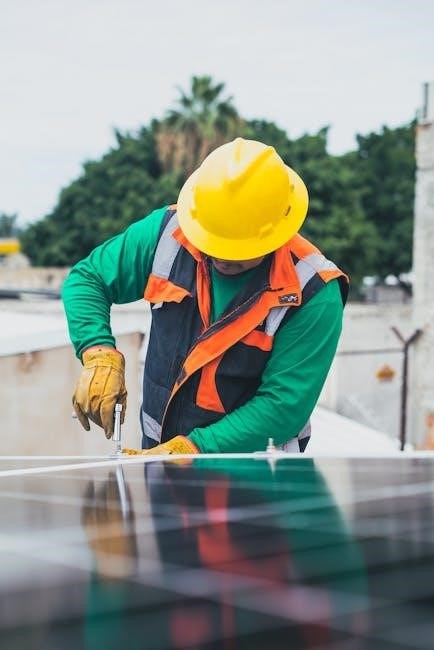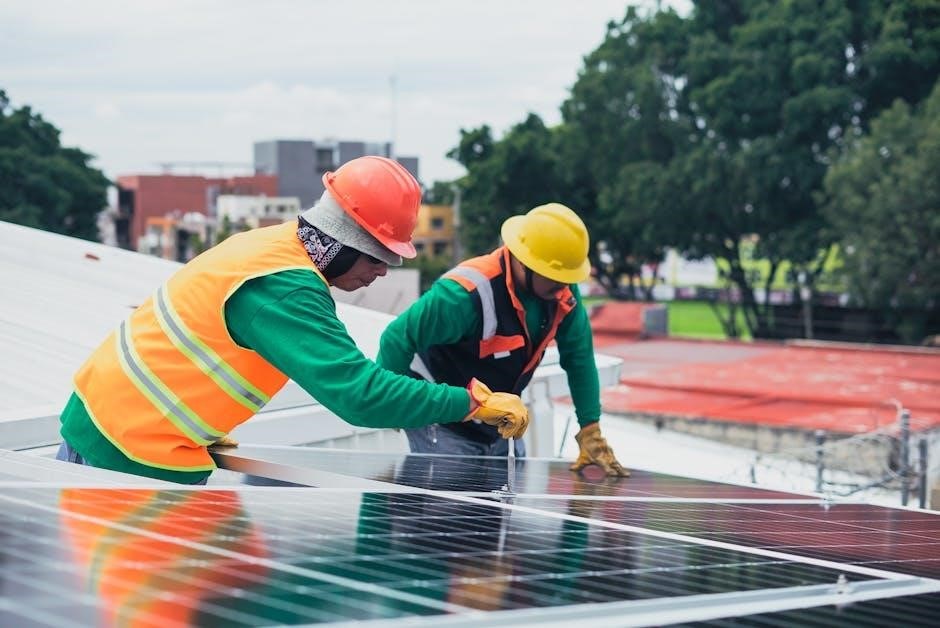Generac 22kW Installation Manual: A Comprehensive Guide
This manual provides a detailed overview of the Generac 22kW generator’s features, functionality, and step-by-step setup guide. It includes component locations, access panel removal, installation guidelines, maintenance schedules, and troubleshooting. This comprehensive guide ensures a safe and reliable installation process for homeowners and installers alike.
The Generac 22kW generator, part of the Guardian Series, stands as one of the most powerful air-cooled generators available for home standby power. Designed to provide whole-house backup for many homes, this generator ensures uninterrupted power during outages. It comes equipped with features like Wi-Fi connectivity and automatic transfer switch compatibility, enhancing its functionality and ease of use.

This model offers flexibility in installation, with options for both indoor and outdoor placement thanks to its NEMA 3R rated transfer switch. The Generac 22kW is engineered for reliability, durability, and efficiency, reflecting Generac’s commitment to quality since 1959.
Whether you’re looking to protect your home from power interruptions or seeking a dependable backup power source, the Generac 22kW generator provides a robust solution. Its compatibility with automatic transfer switches ensures a seamless transition to generator power within seconds of an outage. Furthermore, its air-cooled design simplifies maintenance, making it a practical choice for homeowners. This generator represents a significant investment in peace of mind, safeguarding your home and family during unexpected power failures.
Understanding the Manual’s Purpose and Scope
This installation manual serves as a comprehensive guide for safely and effectively installing the Generac 22kW generator. Its primary purpose is to provide detailed instructions and essential information to ensure proper setup, operation, and maintenance of the generator system.
The manual’s scope encompasses all aspects of the installation process, from pre-installation considerations such as site selection and fuel type determination to the actual physical installation, electrical connections, and initial startup procedures. It also covers essential maintenance schedules and troubleshooting tips to keep the generator running smoothly for years to come.
This guide is intended for use by qualified installers and homeowners with a solid understanding of electrical and mechanical systems. It emphasizes safety precautions and best practices to prevent damage to the equipment and ensure personal safety. By following the instructions and guidelines outlined in this manual, users can confidently install and maintain their Generac 22kW generator, maximizing its performance and longevity.
The manual also aims to clarify complex topics such as wiring diagrams, automatic transfer switch connections, and fuel conversion processes, making the installation process more accessible and understandable.

Pre-Installation Considerations
Before commencing the installation of a Generac 22kW generator, several crucial considerations must be addressed to ensure a smooth and successful setup. Firstly, thoroughly review local building codes and regulations to obtain any necessary permits and ensure compliance with safety standards. This step is critical to avoid potential legal issues and ensure the installation meets all requirements.
Next, assess your property’s electrical load to determine if the 22kW generator adequately covers your power needs during an outage. Calculate the total wattage of essential appliances and devices to ensure the generator can handle the load without being overloaded. Consider future power requirements to avoid undersizing the generator.
Fuel type is another vital aspect; Decide whether to use natural gas (NG) or liquid propane (LP) based on availability, cost, and personal preference. Ensure you have a sufficient supply of the chosen fuel source and that the gas line is properly sized for the generator’s consumption.
Finally, carefully evaluate potential installation locations, considering factors like proximity to the house, noise levels, ventilation, and accessibility for maintenance. A well-planned location minimizes disruptions and ensures optimal generator performance.
Site Selection and Preparation
Selecting an appropriate site for your Generac 22kW generator is paramount for its efficient operation and longevity. The chosen location should be level, stable, and capable of supporting the generator’s weight, preventing settling or tilting over time. Ensure the area is free from obstructions like trees, shrubs, or fences that could impede airflow or maintenance access.
Consider proximity to your home, keeping in mind noise levels and exhaust fumes. Maintain a safe distance from windows, doors, and ventilation systems to prevent fumes from entering the house. Adhere to local regulations regarding minimum distances from property lines and other structures.
Proper ventilation is crucial for dissipating heat generated during operation. The site should allow for ample airflow around the generator to prevent overheating and ensure optimal performance. Avoid enclosed spaces or areas with restricted airflow.
Prepare the site by clearing any debris, leveling the ground, and creating a solid foundation. A concrete pad is recommended for stability and to prevent the generator from sinking into the soil. Ensure the pad is adequately sized to accommodate the generator and any associated equipment.
Electrical Wiring and Connections
Establishing secure and compliant electrical wiring and connections is critical for the safe and reliable operation of your Generac 22kW generator. This process involves connecting the generator to your home’s electrical system through an automatic transfer switch (ATS), ensuring seamless power transfer during outages.
Employ appropriately sized wiring, typically copper or aluminum, capable of handling the generator’s maximum current output. Consult local electrical codes and the generator’s manual for specific wire gauge requirements to prevent overheating and potential hazards.
Ensure all connections are tight, secure, and properly insulated to prevent short circuits and electrical shocks. Use UL-listed connectors and fittings designed for outdoor use to withstand environmental conditions.
The grounding system is paramount for safety. Connect the generator to a dedicated grounding rod, ensuring a low-resistance path to earth. This protects against electrical faults and minimizes the risk of electrocution.
Properly label all wires and connections for easy identification during maintenance or troubleshooting. This helps prevent confusion and ensures accurate reconnection after servicing.
Always disconnect power before working on any electrical components and verify the absence of voltage with a reliable meter.
Wiring Diagram Overview
The wiring diagram is a crucial tool for understanding the electrical connections within your Generac 22kW generator system. This visual representation illustrates how various components are interconnected, including the generator, automatic transfer switch (ATS), and your home’s electrical panel.
Familiarize yourself with the diagram before commencing any electrical work. Identify key components such as the main circuit breaker, neutral connections, ground connections, and control wiring.
Pay close attention to wire colors and markings, as these indicate the function of each wire. Ensure all connections match the diagram to prevent miswiring and potential damage to the generator or electrical system.
The wiring diagram also provides information on voltage levels, current ratings, and fuse sizes. Use this information to select appropriate wiring and protective devices.
For systems with automatic transfer switches, the wiring diagram illustrates how the ATS switches between utility power and generator power during an outage.
If you encounter any discrepancies or uncertainties while interpreting the wiring diagram, consult a qualified electrician or Generac service technician.
Always keep a copy of the wiring diagram readily available for future reference during maintenance or troubleshooting.
Connecting to Automatic Transfer Switches (ATS)
Connecting your Generac 22kW generator to an Automatic Transfer Switch (ATS) is a critical step in ensuring seamless backup power during utility outages. The ATS automatically switches your home’s electrical supply from the utility grid to the generator when it detects a power loss.
Begin by ensuring both the generator and utility power are disconnected before making any connections. Carefully follow the wiring diagram provided with your ATS to identify the correct terminals for the generator’s output wires.
Typically, the ATS will have terminals for line voltage (L1 and L2), neutral, and ground. Connect the corresponding wires from the generator to these terminals, ensuring secure and tight connections.
Pay close attention to wire sizes and ampacity ratings to prevent overheating and potential fire hazards. Use appropriately sized conductors and connectors as specified in the ATS installation manual.
For proper operation, the ATS also requires control wiring connections to the generator. These wires typically signal the ATS to start the generator upon detecting a power outage.
Once all connections are made, double-check the wiring against the diagram and ensure all terminals are securely tightened. Finally, test the system to verify that the ATS switches correctly between utility and generator power.

Gas Line Installation (NG/LP)
Proper gas line installation is crucial for the safe and efficient operation of your Generac 22kW generator, whether using Natural Gas (NG) or Liquid Propane (LP). This process involves connecting the generator to your home’s gas supply, ensuring a leak-free and properly sized gas line.
Begin by determining the appropriate gas supply pressure required by your generator, consulting the generator’s specification sheet. Ensure your home’s gas supply meets these requirements. Consult a qualified gas technician if necessary.
Use appropriately sized gas pipes, typically black iron or approved flexible gas lines, based on the distance from the gas meter and the generator’s gas consumption rate. The pipe size must be adequate to deliver the required gas volume without significant pressure drop.
Install a manual shut-off valve near the generator for emergency shut-off. Apply gas-rated pipe sealant to all threaded connections to prevent leaks.
Once the gas line is connected, conduct a thorough leak test using a gas leak detector or a soap-and-water solution. Check all connections, fittings, and the shut-off valve.
Finally, ensure the gas line is properly supported and protected from physical damage. A qualified gas technician should perform or inspect the installation to ensure compliance with local codes and safety standards.
Fuel Type Considerations and Conversion
The Generac 22kW generator is designed to operate on either natural gas (NG) or liquid propane (LP), offering flexibility based on fuel availability and homeowner preference. Selecting the appropriate fuel type is a crucial initial step in the installation process.
Natural gas is typically supplied via a municipal pipeline, offering a continuous and reliable fuel source. However, natural gas pressure and availability can vary depending on location and demand. Liquid propane, on the other hand, requires on-site storage in a propane tank. The tank size must be sufficient to meet the generator’s fuel consumption needs during extended outages.
If converting the generator from one fuel type to another, it is essential to follow the manufacturer’s instructions precisely. Typically, this involves adjusting the fuel regulator and air-fuel mixture settings. Some models may require a fuel conversion kit, which includes the necessary components for safe and efficient operation on the new fuel type.
Incorrect fuel type settings can lead to poor performance, engine damage, or even dangerous conditions. Always consult a qualified technician when performing fuel conversions to ensure proper configuration and safe operation. Verify the generator’s fuel selection switch is correctly set for the chosen fuel type.
Installation Process: Step-by-Step Guide
The installation of a Generac 22kW generator involves several critical steps, requiring careful attention to detail and adherence to safety guidelines. First, ensure the site is properly prepared, including a level concrete pad and adequate clearance around the unit for ventilation and maintenance access. Next, carefully position the generator on the pad, ensuring it is securely anchored to prevent movement.
Connect the electrical wiring, including the main power cables, control wires, and grounding connections, following the wiring diagram provided in the manual. Ensure all connections are tight and properly insulated to prevent electrical hazards. Then, connect the fuel line, whether natural gas or liquid propane, ensuring all fittings are leak-free and compliant with local codes.
Install the automatic transfer switch (ATS) according to its specific instructions, typically near the main electrical panel. Connect the ATS to the generator and the electrical panel, ensuring proper wiring and grounding. Before starting the generator, double-check all connections, fuel lines, and wiring for accuracy and safety. Finally, perform an initial startup, following the manufacturer’s recommended procedures, and verify that the generator is operating correctly, transferring power seamlessly during a simulated power outage.
Initial Startup and Testing

Once the Generac 22kW generator is installed, the initial startup and testing phase is crucial to ensure proper functionality. Begin by reviewing all connections: electrical, fuel, and control wiring, verifying tightness and correct polarity. Next, prime the fuel system according to the manual, allowing fuel to flow to the engine. Turn the generator’s main switch to the “Manual” or “Test” position.
Initiate the startup sequence, observing the engine’s response and listening for any unusual noises. Monitor the generator’s control panel for error codes or warnings, addressing any issues promptly. Allow the generator to run for a brief period to stabilize, then perform a simulated power outage by disconnecting the main power supply. Observe the automatic transfer switch (ATS) as it switches the load to the generator.
Verify that all essential circuits are powered correctly and that the generator is providing stable voltage and frequency. Return the main power supply and confirm that the ATS switches back seamlessly. Document the startup and testing process, noting any adjustments or repairs made. This thorough testing ensures reliable backup power during actual outages.
Maintenance and Service Schedule
Regular maintenance is critical to ensure the Generac 22kW generator’s longevity and reliable performance. Adhering to the recommended service schedule minimizes potential issues and maximizes uptime. The schedule typically includes tasks performed at specific intervals, such as weekly, monthly, and annual checks. Weekly inspections should involve visual checks for leaks, damage, and debris around the generator.
Monthly tasks include running the generator for a short exercise cycle to lubricate internal components and maintain battery charge. Annual service typically requires a more comprehensive inspection, including oil and filter changes, spark plug replacement, air filter cleaning or replacement, and valve adjustments. It’s crucial to use genuine Generac parts and fluids to maintain warranty coverage and ensure optimal performance.
Keep detailed records of all maintenance performed, including dates, tasks completed, and parts replaced. Generac recommends contacting an Independent Authorized Service Dealer (IASD) for assistance with complex maintenance procedures or repairs. Following the maintenance schedule ensures that the generator is ready to provide reliable backup power when needed.
Troubleshooting Common Issues
Even with proper installation and maintenance, the Generac 22kW generator may encounter occasional issues. This section provides guidance on troubleshooting common problems, aiding in quick resolution. Before troubleshooting, consult the manual and ensure all safety precautions are followed. One common issue is the generator failing to start during a power outage. Check the battery voltage, fuel supply, and spark plugs.
Error codes displayed on the generator’s control panel provide valuable diagnostic information. Consult the manual for a list of error codes and their corresponding solutions. Another common problem is the generator shutting down unexpectedly. Overheating, low oil pressure, or a tripped circuit breaker can cause this. Allow the generator to cool down, check the oil level, and reset the circuit breaker.
If the generator runs but doesn’t supply power, inspect the transfer switch and wiring connections. If troubleshooting steps don’t resolve the issue, contact a qualified technician or Generac’s customer support for assistance. Remember to record any error codes or symptoms to provide helpful information during the support call.
